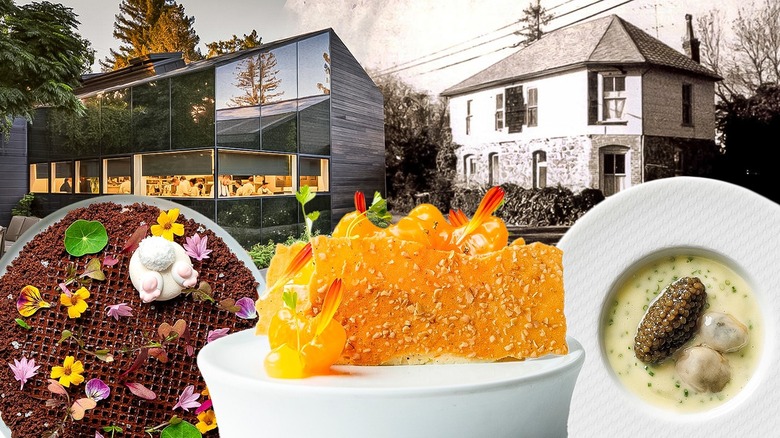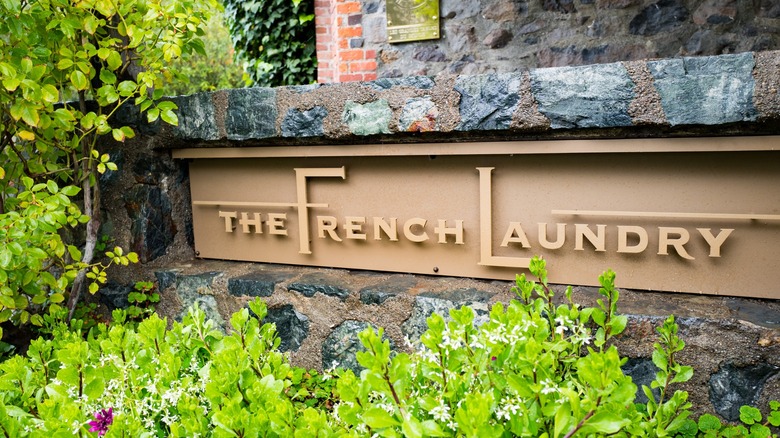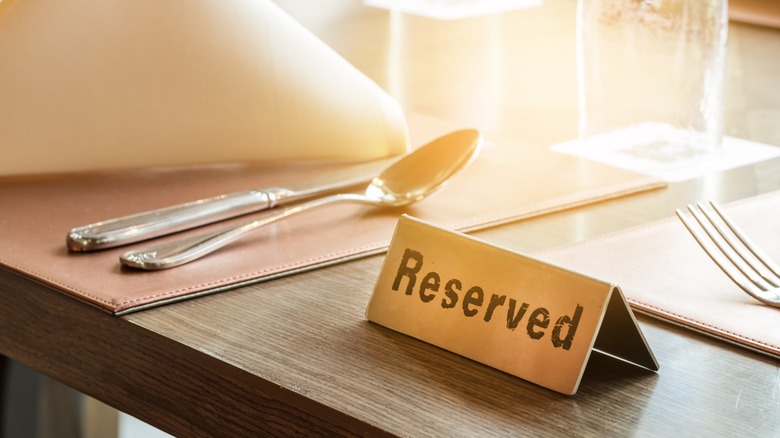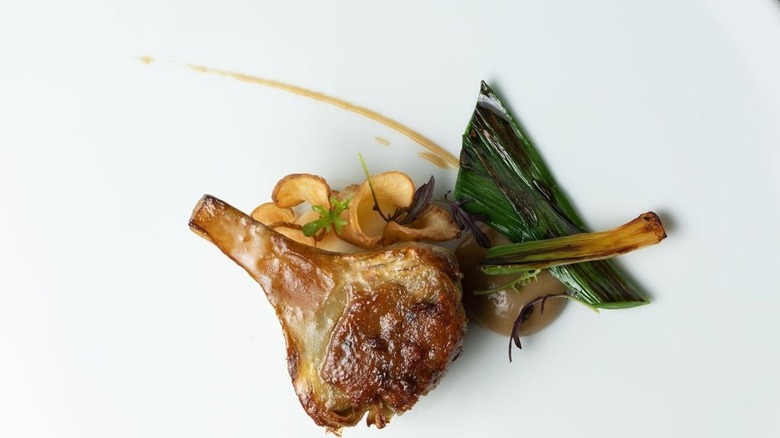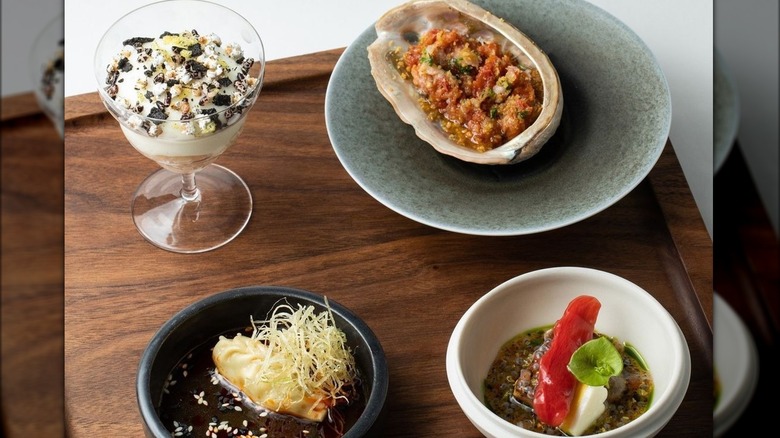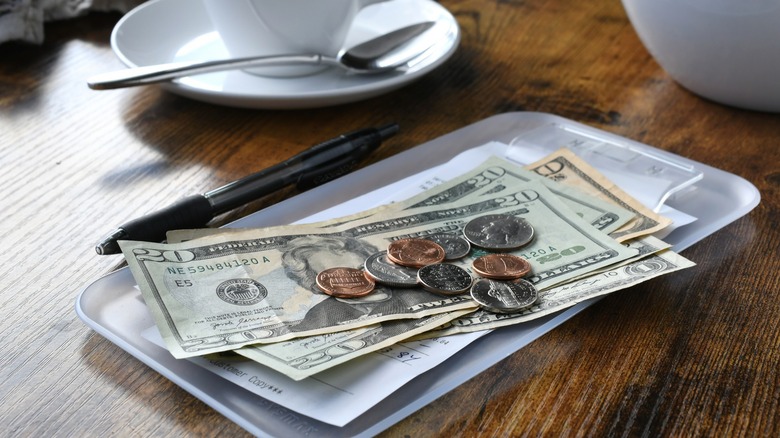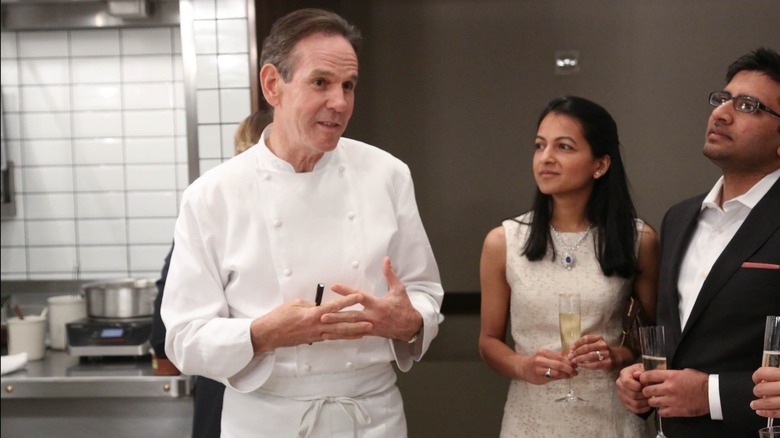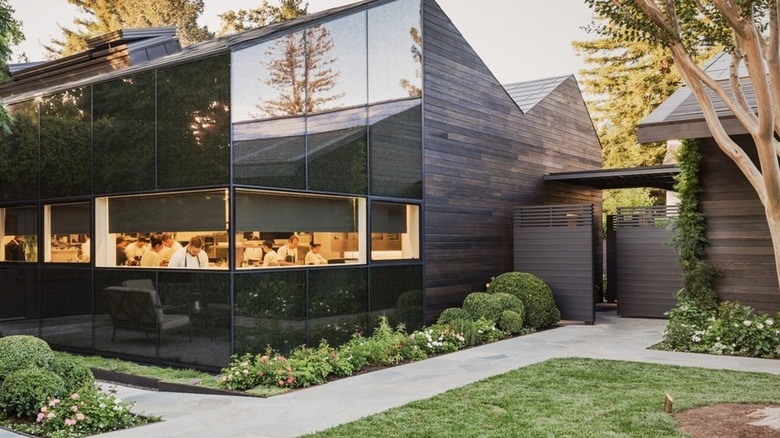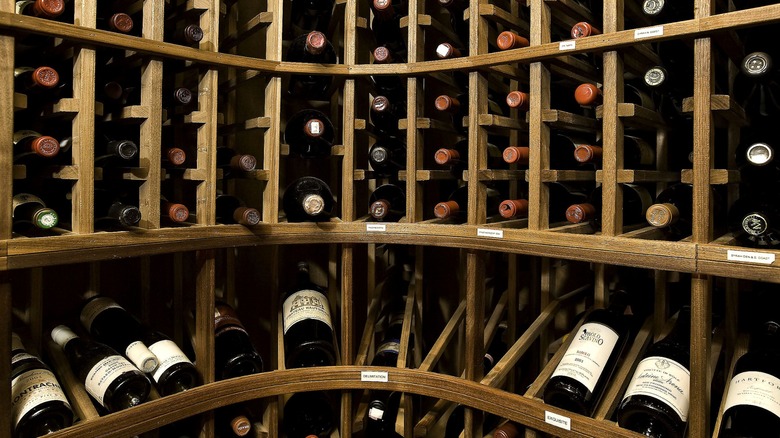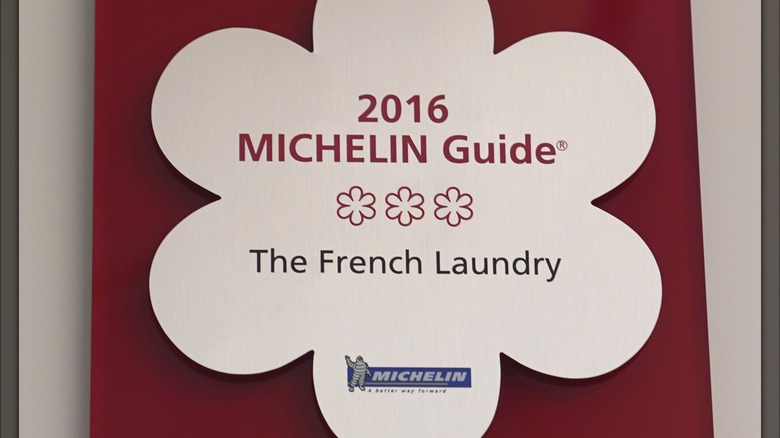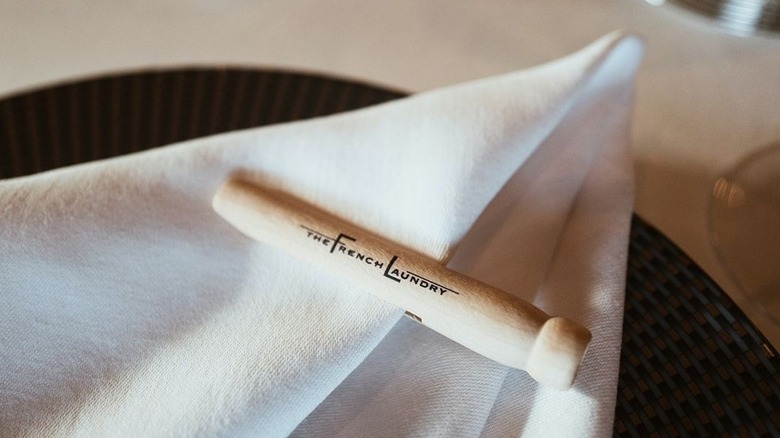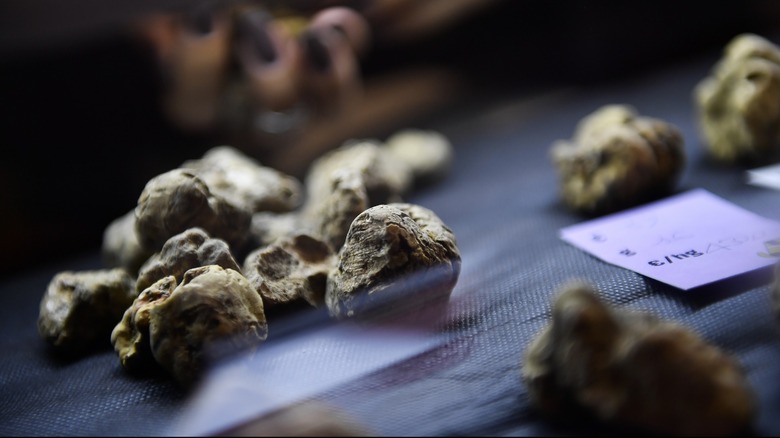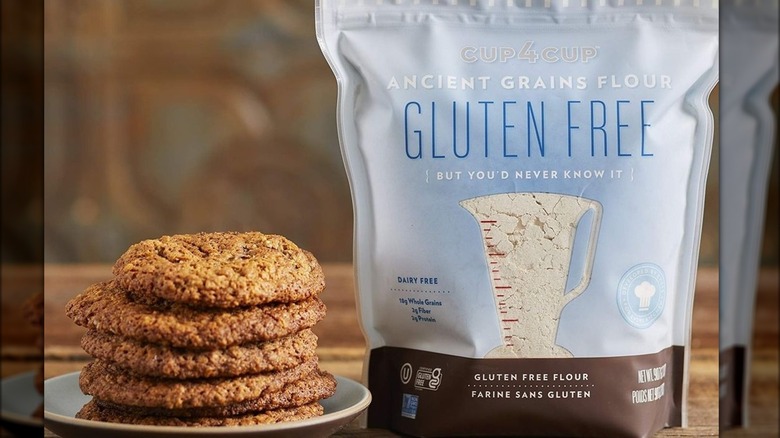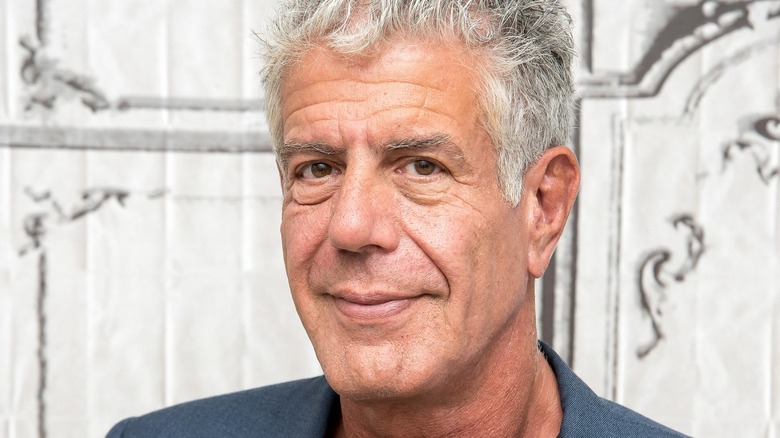13 Facts You Should Know About The Iconic French Laundry
If you've managed to wrangle a reservation at the famed French Laundry in Yountville, California — or are just curious about the hugely celebrated restaurant — you may be frantically Googling things so you have an advanced understanding of how everything works. Don't fear – we've got your back. As well, the staff is known for being incredibly welcoming and gracious. Even with the reputation the restaurant has, The French Laundry experience isn't stuffy at all.
First, you should know not to arrive too early: There's no bar for pre-dinner cocktails and they don't open the doors until the time the seating begins. However, the restaurant is surrounded by its own gardens and greenhouses you're free to stroll through. And you're welcome to take photos — selfies by the sign or in front of the signature blue door, of the food, of anything you like. But it's the food, of course, that you've really come for. Read on for more facts and tips about The French Laundry, one of the most famous restaurants in America.
Where did the name come from?
The iconic river rock and wooden building was first built in 1900 as a home for Pierre Guillaume's Eagle Saloon and was added to the National Register of Historic Places in 1978. In 1906, a law was passed that prohibited the sale of alcohol within a mile of a veteran's building and the building was sold. In 1920, it was purchased by John Lande, who turned it into a French-style steam laundry that remained open until the 1970s, and the restaurant's name honors the building's unique history.
In 1978, the building was purchased by chef Sally Schmidt and her husband Don, the mayor of Yountville. The Schmidts successfully applied to the National Registry and had the building designated a historic landmark. They decided to keep the name of the building as the community referred to it as the French laundry already. Chef Thomas Keller purchased the restaurant in 1994 and continued to call it The French Laundry, adding the iconic wooden clothes peg to the restaurant's branding. There are a few other subtle nods to the building's past as well as the fabric care symbols embossed on the lampshades.
Get ready to make a reservation far in advance
Given the nature of the dining experience, it's understandable that getting a reservation isn't easy. The restaurant holds just 60 people and because of the length of the meal, only two seatings are available each day — lunch and dinner. Getting a reservation is a top priority for food lovers so the competition is fierce.
To begin, the restaurant opens the reservations one month in advance, on the first of the month. Hopeful diners used to be able to use the phone and cross their fingers that they got through. Recently, the restaurant has moved to online bookings (through Tock) that work the same way, starting at precisely 10 a.m. (Pacific time). If you're unsuccessful, you'll have to wait another month and try again. It used to be possible to score at the last minute through websites like Open Table, but even that's a thing of the past now. There are a few other options for those who are unwilling to let go of your dream so easily, including making friends with a celebrity or taking advantage of your Black AmEx card's concierge service.
French Laundry only serves a tasting menu that is different every day
Part of the appeal of The French Laundry is a nine-part tasting menu that changes every day. There are two options for the menu, the Chef's Menu (includes meat and seafood) and the vegetarian Tasting of Vegetables version. The restaurant firmly subscribes to a locavore ethos, relying on hand-picked suppliers as close to the venue as possible as well as their own on-site gardens. Keller focuses on classic French cuisine with a distinct California influence, using the freshest ingredients and classic techniques.
While the menu changes every day, there are a few touchstones that have become part of Chef Keller's signature, including a salmon and crème fraîche cornet, Oysters and Pearls (oysters and caviar served in sabayon), and the final course mignardises — lush chocolate truffles. Recently, Keller has gotten away from offering a bread basket, instead going with a bread course that is made up of exquisite offerings from Bouchon Bakery, Keller's bakery.
Expect many small servings
Judging by all the forums and posts online, first-timers to the experience have a lot of questions about what to expect. And the advice doesn't always seem to help — there are a lot of opinions out there. Make sure that you understand one thing, though. You're going to be served a tasting menu, meaning a lot of tiny plates, instead of the typical large entrée that you might be used to. How you prepare for this is up to you, but the consensus is that even though the plates are small, each serving is rich and superbly tasty and many online reviews recommend comfortable pants for the experience.
Many diners will opt to split the Chef's Menu and the Tasting of Vegetables between them to get a small taste of each, thus optimizing the experience. Again, keep in mind that the portions are quite small (just a couple of bites of each) so if you're not that good at sharing, you might need to look deep inside yourself before deciding how to proceed.
Remember that the tip is included in the bill
Aside from the food, the impeccable service is another reason that The French Laundry is lauded as one of the best restaurants in America. The staff is enormous, with each member having a very specific role to perform, and they're all highly trained to be as capable as possible. In particular, the waitstaff is encouraged to be friendly and welcoming, rather than stiff or aloof as you might expect in such a high-end dining room. Diners are encouraged to ask questions about the menu and ingredients to get the most from their experience.
Thomas Keller has often spoken about the need to pay staff, especially in the food industry, a fair wage. He first implemented a service charge at his New York restaurant Per Se in 2005, with The French Laundry following soon after. At the time, he was one of the first restaurateurs to do so. While many places will impose a service charge on large groups, Keller believes that charging all patrons a service charge is the best way to unify his workforce. All his employees are paid an hourly wage and split the service charges at the end of the night. At The French Laundry, you don't have to worry about ponying up extra cash as the charge is included in the menu price.
You can often meet the chef in the kitchen
While Keller is the owner and head chef, he works with a large staff of line cooks who are given a large part of the responsibility for each day's menu. With so many employees, everyone is given very clear expectations of their role; staff are given specific tasks to ensure nothing is overlooked. This includes planning the daily menu – each line cook is advanced enough to be running their own kitchen and as such, each prepares a specific dish for the menu.
After spending up to six hours eating there, you may feel comfortable enough to request an introduction to the chef. This means meeting the staff of line chefs responsible for each course, as well as Chef Keller — if he's there. The kitchens at The French Laundry and Per Se are video-linked in real-time, so even if he's in the East Coast kitchen, you might still get to see him in action. Bring your French Laundry cookbook if you'd like it signed as well.
The restaurant reno was inspired by the Louvre
With a historical designation, there are some limits to what kind of renovations can be made to a building that's over a century old. However, in 2017 work was finished on updating some parts of the iconic Napa Valley building while maintaining the historical aspects. The kitchen was given a significant overhaul, making it 25% bigger. The $10 million renovation was inspired by the Louvre in part, through the contrast between modern glass and historic wood. As well, a large part of the change was to strike a balance between an industrial and a home kitchen, in a bid to make it functional yet not austere.
The kitchen was given large windows so that patrons in the back garden are able to see the chefs at work, while outdoor dining spaces mean that more people can eat at each seating. The remodel also upgraded the wine cellar to hold 16,000 bottles (that's why the wine list is 90 pages, y'all) and included a curving, white kitchen ceiling that is reminiscent of an unfurling tablecloth.
During renovations, $500,000 worth of wine was stolen
A three-year renovation of the restaurant unveiled a gorgeous new kitchen and outdoor seating area, but it also left the incredible cellar less impervious to sticky fingers. The December 2014 French Laundry remodel meant that the building was empty and, as it was Christmas in a small town, there was no one around. By busting open a heavy steel door and breaking in, two men made their way to the cellar and its famous wine collection.
The French Laundry wine list is a 90-page tome that lists the best of the best wines and Champagnes you can imagine, some running in the five-digit category. To put it in context, they made off with $500,000 worth of wine and only needed about 110 bottles to do so. Most of the wine was later recovered, mostly because reselling a $10,000 bottle of stolen Domaine de la Romanée-Conti is nearly impossible. The very small pool of eligible buyers will also know the only possible brokers of such a rare commodity; this meant that the thieves were identified as soon as they tried to sell the goods.
It has three Michelin stars
It's not just the exclusivity that makes dining at The French Laundry a dream dining experience. Chef Keller is unique for a very good reason – he's the only American chef to be awarded three Michelin stars (their highest rating) for two of his restaurants. Per Se, his New York restaurant was awarded in 2006 with The French Laundry being awarded the next year.
Michelin stars are awarded to restaurants that are exceptional culinary destinations in select cities. Originally produced as a way to increase interest in the newly invented automobile, Michelin Tires gave the guide away for free. Based in France, it included instructions on how to change a tire, maps, and listings of places to stop while driving popular routes throughout France. By 1955, the guide began awarding exceptional, yet affordable, restaurants with a three-star system. Even a one-star designation is an honor, meaning "a very good restaurant in its category". Three, however, is the ultimate recognition for a spot classified as "exceptional cuisine, worth a special journey".
Expect to pay at least $390 per person
Now that you've heard about the difficulty of getting a reservation, the Michelin stars, the exquisite multi-course menus, and everything else, what would you be willing to pay? You should expect to pay at least $390 per person for the nine-course menu alone, depending on where you choose to sit. The bill climbs as you add on any extras, which can include Wagyu beef or truffles.
Wine is also extra and can add a lot to the bill. By the glass, wines range from as high as $55 for white or red, with bottles going for hundreds (to thousands) of dollars. You can instead bring your own bottle of wine (you're in Napa Valley after all) and pay a $200 corkage fee if you prefer. Note, however, that the website states that visitors are only allowed one bottle per every two people at the table. If you're not a wine expert and money is no object, enlist the help of the sommelier to guide you through the 90-page wine list or just leave the pairings up to them for excellent results.
White truffle season is a big deal for the French Laundry
White truffles are a big deal at The French Laundry. When they are in season, the restaurant takes full advantage of them and offers a spectacular specialty menu. Truffles are an expensive delicacy, with some important differences between the black and white types. White truffles can't be cultivated, unlike black, making them much more rare. As well, they are far more delicate and don't last as long. This drives up the price and cachet, making them perfectly suited for an already exclusive menu.
They are such a limited resource that even The French Laundry can only score enough for one day's menu — and Chef Keller is known for never discussing prices with suppliers as he has no problem paying for what he wants. Unfortunately, the supply is so limited that even he can only get so many of the delectable little nuggets. However, if you are willing to settle for something a little less rare, they do a black truffle and caviar dinner more often, starting at $1000 per person.
Cup4Cup gluten-free flour was another hit for the French Laundry kitchen
The restaurant itself is located on a large piece of property in an incredibly fertile part of Northern California, making it possible for many of the herbs, fruits, and vegetables used to be grown on-site. This fits in with the brand's ideals but also ensures that everything used is of the best quality possible. In 2010, when the kitchen wanted to start making a gluten-free version of the signature salmon cornet, Keller decided that making their own gluten-free flour was the only way to proceed.
Cup4Cup is gluten-free flour created by French Laundry chefs and used in all the non-wheat flour baking at the restaurant. It was so successful at The French Laundry that Chef Keller decided to start selling it in grocery stores for home bakers. Used in a simple 1:1 ratio as regular flour, it was devised to work and taste like it too. A few different varieties including ancient grains and a wholewheat version are available, as well as several baking mixes that all sound pretty tempting.
Anthony Bourdain was a huge fan
Anthony Bourdain was known for having a lot of opinions and not holding back about them, which is pretty typical of anyone whose life revolves around food – let's just agree that we're passionate and leave it at that. Bourdain, however, became known throughout his career for also being pretty uncompromising when it came to his integrity, making his opinions easier to trust perhaps. And his opinion when it came to Thomas Keller and The French Laundry in particular? "The best sit-down, multicourse, white-tablecloth meal of my life" Bourdain said for Men's Health when talking about restaurants he adored.
If you're a fan of all things Bourdain, you may have already seen the episode "The French Laundry Experience" in Season 1 of "Anthony Bourdain's A Cook's Tour," where he is stunned into silence by the multi-course meal. Now, this may have been partly because it was a 20-course meal rather than the regular nine that the normies get, but we suspect it has more to do with his ability to appreciate divine food and service even better than we can.
